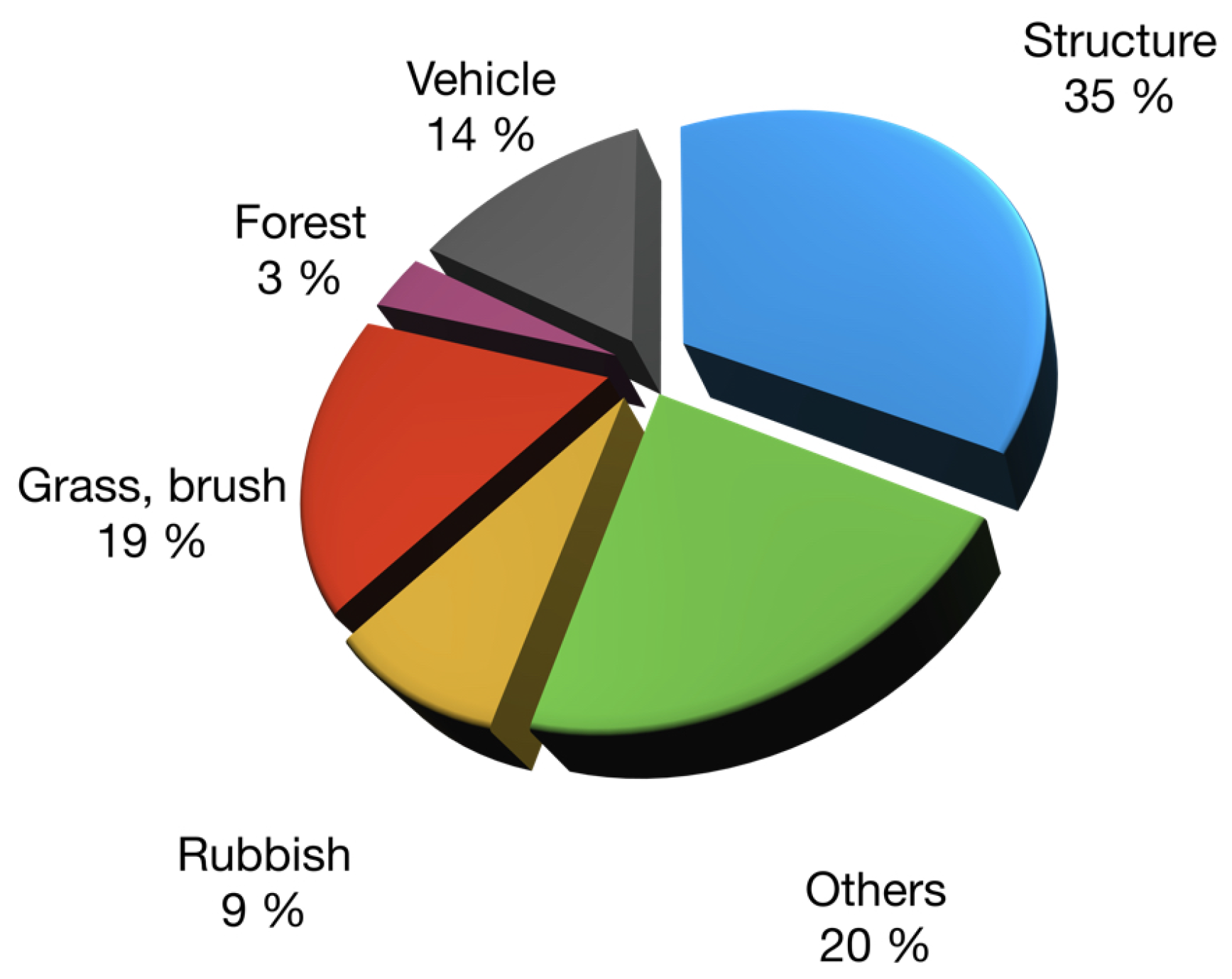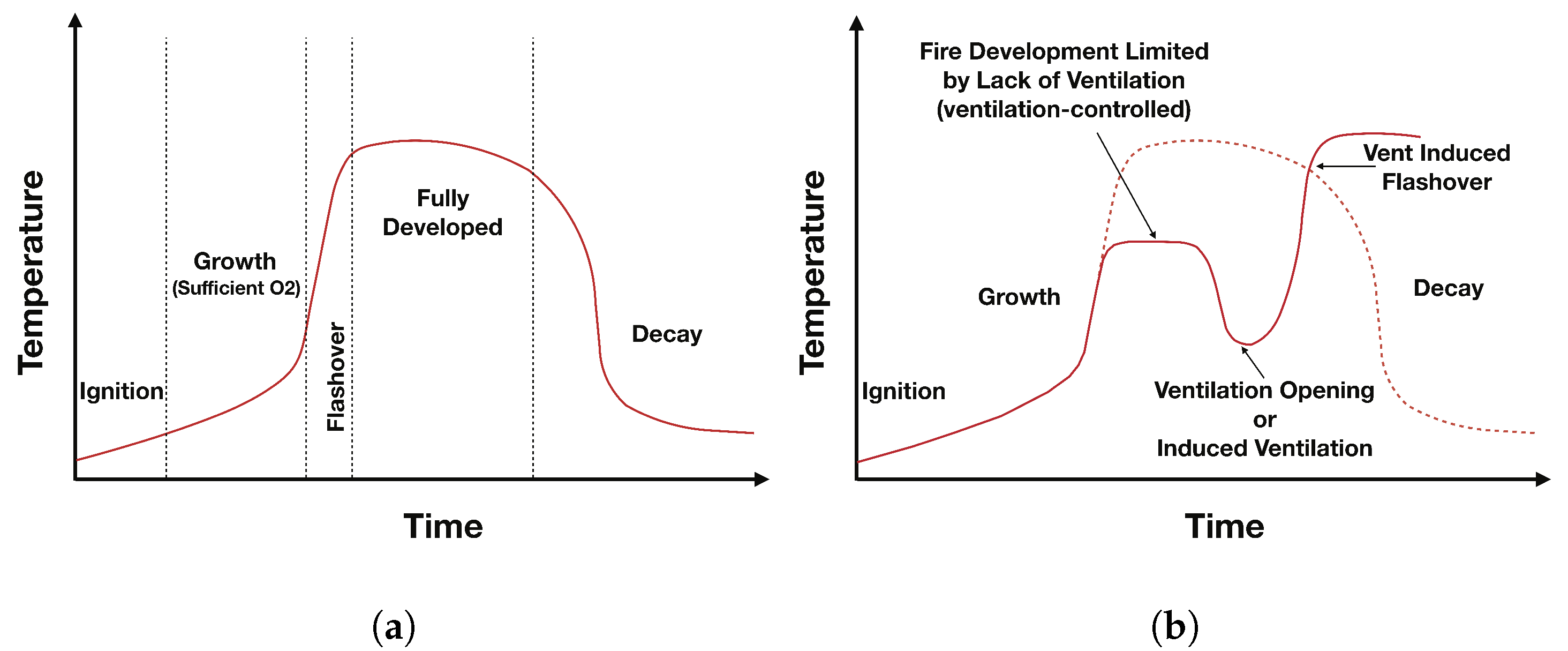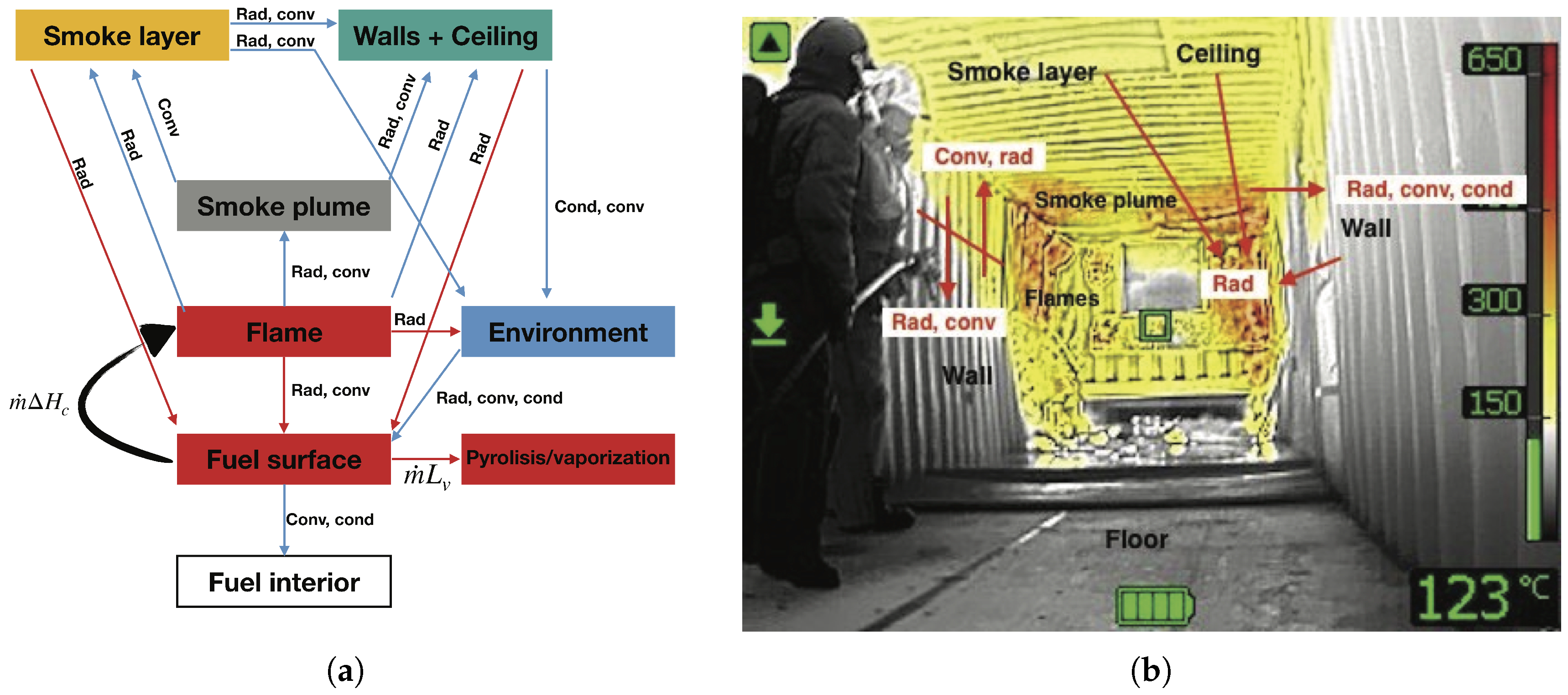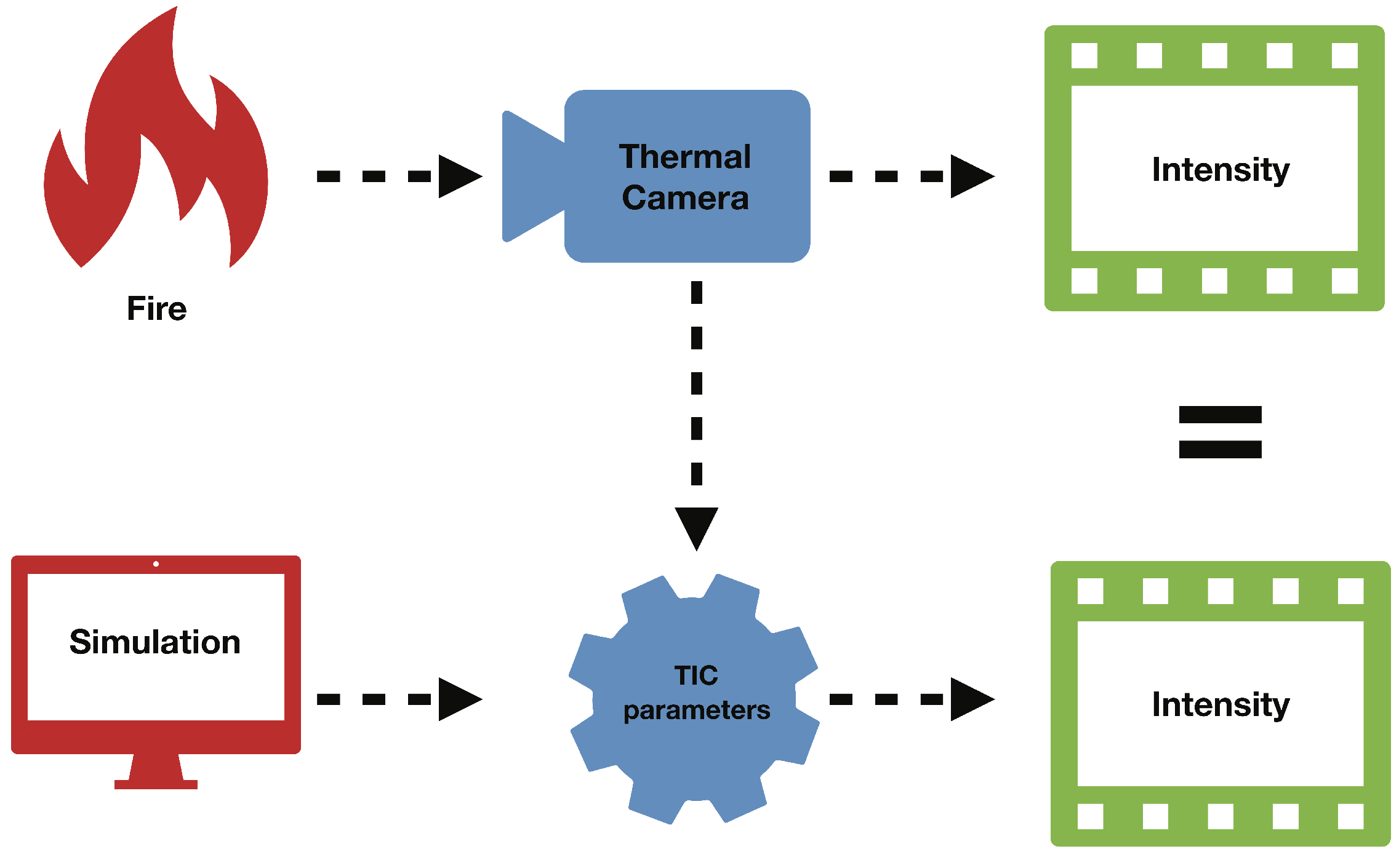A Review of Modelling and Simulation Methods for Flashover Prediction in Confined Space Fires
Abstract
1. Introduction
- The enclosure is ventilated, the oxygen consumption is less than the available amount.
- The room is under-ventilated (lack of inlet air or lack of an outlet for the smoke). During the combustion process, oxygen levels in the enclosure decrease. No open vents or oxygen displacement by combustion gases can be the causes.
2. Modelling and Simulation of Flashover Phenomenon
2.1. Flashover Modelling
2.2. Flashover Simulation
3. Comparing Fire Dynamics Simulator Data with Thermal Camera Images
4. Flashover Occurrence Prediction
- Length of the compartment (varies randomly from 2 to 10 m)
- Width of the compartment (varies randomly from 2 to 10 m)
- Height of the compartment (varies randomly from 2 to 10 m)
- Maximum heat release rate (varies randomly from 10 to 6000 kW)
5. Challenges An Opportunities
6. Conclusions and Future Work
Author Contributions
Funding
Acknowledgments
Conflicts of Interest
References
- World Fire Statistics; Technical Report; CTIF: Ljubljana, Slovenia, 2018.
- Merel Ruiter, M.; Jana Domrose, M. Fatal Residential Fires in Europe; Technical Report; Institute for Safety, Fire Service Academy: Arnhem, The Netherlands, 2018. [Google Scholar]
- National Fire Protection Association. Available online: https://www.nfpa.org.
- National Fire Protection Association. NFPA 921; National Fire Protection Association: Quincy, MA, USA, 2004; p. 268. [Google Scholar]
- Merci, B.; Beji, T. Fluid Mechanics Aspects of Fire and Smoke Dynamics in Enclosures; CRC Press/Balkema: Ghent, Belgium, 2016; p. 362. [Google Scholar]
- Kawagoe, K. Fire Behavior IRooms, 27th ed.; Building Research Institute, Ministry Construction of Tokyo: Tokyo, Japan, 1958. [Google Scholar]
- Vandecasteele, F.; Merci, B.; Jalalvand, A.; Verstockt, S. Object Localization in Handheld Thermal Images for Fireground Understanding. In SPIE 10214; Bison, P., Burleigh, D., Eds.; International Society for Optics and Photonics: Bellingham, WA, USA, 2017; p. 1021405. [Google Scholar] [CrossRef]
- Huseynov, J.; Boger, Z.; Shubinsky, G.; Baliga, S. Optical flame detection using large-scale artificial neural networks. In Proceedings of the 2005 IEEE International Joint Conference on Neural Networks, Montreal, QC, Canada, 31 July–4 August 2005; IEEE: Piscataway, NJ, USA, 2005; Volume 3, pp. 1959–1964. [Google Scholar] [CrossRef]
- Huseynov, J.J.; Baliga, S.B. Optical infrared flame detection system with neural networks. In Advanced Signal Processing Algorithms, Architectures, and Implementations XVII; International Society for Optics and Photonics: Bellingham, WA, USA, 2007; p. 66970L. [Google Scholar] [CrossRef]
- Kacem, A.; Lallemand, C.; Giraud, N.; Mense, M.; De Gennaro, M.; Pizzo, Y.; Loraud, J.C.; Boulet, P.; Porterie, B. A small-world network model for the simulation of fire spread onboard naval vessels. Fire Saf. J. 2017, 91, 441–450. [Google Scholar] [CrossRef]
- Kim, J.H.; Lattimer, B.Y. Real-time probabilistic classification of fire and smoke using thermal imagery for intelligent firefighting robot. Fire Saf. J. 2015, 72, 40–49. [Google Scholar] [CrossRef]
- Lee, E.W.M.; Yuen, R.K.K.; Lo, S.M.; Lam, K.C. Probabilistic inference with maximum entropy for prediction of flashover in single compartment fire. Adv. Eng. Inform. 2001, 6, 179–191. [Google Scholar] [CrossRef]
- Lee, E.W.; Lee, Y.; Lim, C.; Tang, C. Application of a noisy data classification technique to determine the occurrence of flashover in compartment fires. Adv. Eng. Inform. 2006, 20, 213–222. [Google Scholar] [CrossRef]
- Lee, E.W.M.; Yuen, R.K.K.; Lo, S.M.; Lam, K.C.; Yeoh, G.H. A novel artificial neural network fire model for prediction of thermal interface location in single compartment fire. Fire Saf. J. 2004, 39, 67–87. [Google Scholar] [CrossRef]
- Yuen, R.K.; Lee, E.W.; Lo, S.; Yeoh, G. Prediction of temperature and velocity profiles in a single compartment fire by an improved neural network analysis. Fire Saf. J. 2006, 41, 478–485. [Google Scholar] [CrossRef]
- Horng, W.B.; Peng, J.W. Image-based fire detection using neural networks. In 9th Joint International Conference on Information Sciences (JCIS-06); Atlantis Press: Paris, France, 2006. [Google Scholar] [CrossRef]
- Ingberg, S.H. Tests of the Severity of Building Fires. Q. Natl. Fire Prot. Assoc. 1928, 22, 43–61. [Google Scholar]
- Waterman, T.E. Room flashover—Criteria and synthesis. Fire Technol. 1968, 4, 25–31. [Google Scholar] [CrossRef]
- Thomas, P.H. The Fire Resistance Required to Survive A Burn out. Fire Saf. Sci. 1970, 901, 1. [Google Scholar]
- Takeda, H.; Nakaya, I.; Akita, K. Experimental Study of Small Enclosure Fire with Liquid Fuel. Bull. Jpn. Assoc. Fire Sci. Eng. 1978, 28, 39–44. [Google Scholar]
- Martin, S.B.; Wiersma, S.J. An Experimental Study of Flashover Criteria for Compartment Fires; Technical Report; Menlo Park: California, CA, USA, 1979. [Google Scholar]
- Thomas, P.; Bullen, M.; Quintiere, J.; McCaffrey, B. Flashover and instabilities in fire behavior. Combust. Flame 1980, 38, 159–171. [Google Scholar] [CrossRef]
- Babrauskas, V. Estimating room flashover potential. Fire Technol. 1981, 17, 94–103. [Google Scholar] [CrossRef]
- Steckler, K.; Baum, H.; Quintiere, J. Fire induced flows through room openings-flow coefficients. Symp. Combust. 1985, 20, 1591–1600. [Google Scholar] [CrossRef]
- Bishop, S.R.; Drysdale, D.D. Fires in compartments: The phenomenon of flashover. Ser. Math. Phys. Eng. Sci. 1998, 356, 2855–2872. [Google Scholar] [CrossRef]
- Peacock, R.D.; Reneke, P.A.; Bukowski, R.W.; Babrauskas, V. Defining flashover for fire hazard calculations. Fire Saf. J. 1999, 32, 331–345. [Google Scholar] [CrossRef]
- Huo, R.; Jin, X.H.; Shi, C.L.; Chow, W.K. On The Equations For Flashover Fire in Small Compartments. Int. J. Eng. Performance-Based Fire Codes 2001, 3, 158–165. [Google Scholar]
- Yeoh, G.H.; Yuen, R.K.K.; Chen, D.H.; Kwok, W.K. Combustion and Heat Transfer in Compartment Fires. Numer. Heat Transf. Part A Appl. 2002, 42, 153–172. [Google Scholar] [CrossRef]
- Babrauskas, V.; Peacock, R.D.; Reneke, P.A. Defining flashover for fire hazard calculations: Part II. Fire Saf. J. 2003, 38, 613–622. [Google Scholar] [CrossRef]
- Yeoh, G.; Yuen, R.; Chueng, S.; Kwok, W. On modelling combustion, radiation and soot processes in compartment fires. Build. Environ. 2003, 38, 771–785. [Google Scholar] [CrossRef]
- Lee, Y.P.; Delichatsios, M.A.; Silcock, G. Heat fluxes and flame heights in façades from fires in enclosures of varying geometry. Proc. Combust. Inst. 2007, 31, 2521–2528. [Google Scholar] [CrossRef]
- Chen, A.; Francis, J.; Dong, X.; Chen, W. An experimental study of the rate of gas temperature rise in enclosure fires. Fire Saf. J. 2011, 46, 397–405. [Google Scholar] [CrossRef]
- McCaffrey, B.J.; Quintiere, J.G.; Harkleroad, M.F. Estimating room temperatures and the likelihood of flashover using fire test data correlations. Fire Technol. 1981, 17, 98–119. [Google Scholar] [CrossRef]
- Thomas, P.H. Testing products and materials for their contribution to flashover in rooms. Fire Mater. 1981, 5, 103–111. [Google Scholar] [CrossRef]
- International Organization for Standardization. ISO 9705:1993(E) International Standard—Fire Tests—Full Scale Room Test for Surface Products; International Organization for Standardization: Geneva, Switzerland, 1993. [Google Scholar]
- Yeoh, G.H.; Yuen, R.K.K.; Lo, S.M.; Chen, D.H. On numerical comparison of enclosure fire in a multi-compartment building. Fire Saf. J. 2003, 38, 85–94. [Google Scholar] [CrossRef]
- Beard, A.N. Fire Models and Design. Fire Saf. J. 1997, 28, 117–138. [Google Scholar] [CrossRef]
- CFAST. Fire Growth and Smoke Transport Modeling | NIST. Available online: https://pages.nist.gov/cfast/index.html.
- Horvat, A.; Sinai, Y. Numerical simulation of backdraft phenomena. Fire Saf. J. 2007, 42, 200–209. [Google Scholar] [CrossRef]
- Chow, W.K. A Comparison of the Use of Fire Zone and Field Models for Simulating Atrium Smoke-filling Processes. Fire Saf. J. Copyr. 1995, 25, 337–353. [Google Scholar] [CrossRef]
- Aravind Kumar, A.; Kumar, R.; Jain, S. Application of Computational Fluid Dynamics for Different Fire Strengths in a Compartment Using Combustion Modelling. Fire Sci. Technol. 2014, 33, 35–46. [Google Scholar]
- Zhao, G.; Beji, T.; Merci, B. Application of FDS to Under-Ventilated Enclosure Fires with External Flaming. Fire Technol. 2016, 52, 2117–2142. [Google Scholar] [CrossRef]
- FDS-Fire Dynamics Simulator, NIST. Available online: https://pages.nist.gov/fds-smv/.
- Chow, W.K. Evaluation of the Field Model, Fire Dynamics Simulator, for a Specific Experimental Scenario Combustion Chemistry View project. Artic. J. Fire Prot. Eng. 2005. [Google Scholar] [CrossRef]
- Mackay, D.; Barber, T.; Leonardi, E. CFD Model of a Specific Fire Scenario. In Proceedings of the 16th Australasian Fluid Mechanics Conference, Gold Coast, Australia, 3–7 December 2007; p. 5. [Google Scholar]
- Yuen, A.C.Y.; Yeoh, G.H.; Alexander, B.; Cook, M. Fire scene investigation of an arson fire incident using computational fluid dynamics based fire simulation. Build. Simul. 2014, 7, 477–487. [Google Scholar] [CrossRef]
- Evegren, F.; Wickström, U. New approach to estimate temperatures in pre-flashover fires: Lumped heat case. Fire Saf. J. 2015, 72, 77–86. [Google Scholar] [CrossRef]
- Sudheer, S.; Saumil, D.; Prabhu, S. Physical experiments and Fire Dynamics Simulator simulations on gasoline pool fires. J. Fire Sci. 2013, 31, 309–329. [Google Scholar] [CrossRef]
- Newale, A.S.; Rankin, B.A.; Lalit, H.U.; Gore, J.P.; McDermott, R.J. Quantitative infrared imaging of impinging turbulent buoyant diffusion flames. Proc. Combust. Inst. 2015, 35, 2647–2655. [Google Scholar] [CrossRef]
- Rankin, B.A.; Ihme, M.; Gore, J.P. Model-based imaging of mid-infrared radiation from a turbulent nonpremixed jet flame and plume. In Proceedings of the Conference: 8th US National Combustion Meeting, Park City, UT, USA, 19–22 May 2013. [Google Scholar]
- Rankin, B.A.; Ihme, M.; Gore, J.P. Quantitative model-based imaging of mid-infrared radiation from a turbulent nonpremixed jet flame and plume. Combust. Flame 2015, 162, 1275–1283. [Google Scholar] [CrossRef]
- Kim, W.H. DSP Embedded Early Fire Detection Method Using IR Thermal Video. KSII Trans. Internet Inf. Syst. 2014, 8, 3475–3489. [Google Scholar] [CrossRef]
- FAST ver. 3.1.6 Developed by National Institute of Standards and Technology (NIST). Available online: https://www.nist.gov.
- Lakhmi, C.J.; Lim, C.P. Handbook on Decision Making; Springer: Cham, Switerland, 2010. [Google Scholar]
- Lee, E.W.M. An incremental adaptive neural network model for online noisy data regression and its application to compartment fire studies. Appl. Soft Comput. 2011, 11, 827–836. [Google Scholar] [CrossRef]
- Kim, J.H.; Sung, Y.; Lattimer, B.Y. Bayesian Estimation based Real-Time Fire-Heading in Smoke-Filled Indoor Environments Using Thermal Imagery. In Proceedings of the IEEE International Conference on Robotics and Automation (ICRA), Singapore, 29 May–3 June 2017; pp. 5231–5236. [Google Scholar]
- Yun, K.; Bustos, J.; Lu, T. Predicting Rapid Fire Growth (Flashover) Using Conditional Generative Adversarial Networks. Electron. Imaging 2018, 2018, 127-1–127-4. [Google Scholar] [CrossRef]




| Country | Population (Million) | Fatalities Per Capita Per Year (Approx.) | % Fatal Fires (Related to All Residential Fires) |
|---|---|---|---|
| Belgium (2014–2015) | 11.4 | 0.6 per 100.000 | 0.5% |
| Denmark (2011–2012) | 5.8 | 1.1 per 100.000 | 1.2% |
| Estonia (2013–2017) | 1.3 | 3.7 per 100.000 | 4.6% |
| Finland (2011–2012) | 5.53 | 1.4 per 100.000 | |
| Netherlands (2011–2014) | 17 | 0.2 per 100.000 | 0.6% |
| Norway (2016–2017) | 5.3 | 0.5 per 100.000 | 1.3% |
| Poland (2011–2012) | 38 | 1.3 per 100.000 | |
| Sweden (2011–2013) | 10 | 1.1 per 100.000 | 1.2% |
| UK (2014) | 66 | 0.6 per 100.000 | |
| Total | 160.3 | ||
| Total Europe | 742.9 |
| Property Use | Fires | Civilian Deaths | Civilian Injuries | Direct Property Damage (in Millions) |
|---|---|---|---|---|
| One- or two-family homes, including manufactured home | 250,500 (70%) | 2100 (84%) | 8440 (66%) | $5438 (81%) |
| Other multi-family housing | 107,800 (30%) | 410 (16%) | 4280 (34%) | $1271 (19%) |
| Total | 358,300 (100%) | 2520 (100%) | 12,720 (100%) | $6710 (100%) |
| Approximate Radiant Heat Flux (kW/m) | Comment or Observed Effect |
|---|---|
| 170 | Maximum heat flux as currently measured in a post-flashover fire compartment. |
| 80 | Heat flux for protective clothing Thermal Protective Performance (TPP) Test. |
| 52 | Fiberboard ignites spontaneously after 5 s. |
| 29 | Wood ignites spontaneously after prolonged exposure. |
| 20 | Heat flux on a residential family room floor at the beginning of flashover. |
| 16 | Human skin experiences sudden pain and blisters after 5-s exposure with second-degree burn injury. |
| 12.5 | Wood volatiles ignite with intended exposure and piloted ignition. |
| 10.4 | Human skin experiences pain with 3-s exposure and blisters in 9 s with second-degree burn injury. |
| 6.4 | Human skin experiences pain with a second exposure and blisters in 18 s with second-degree burn injury. |
| 4.5 | Human skin becomes blistered with a 30-s exposure, causing a second-degree burn injury. |
| 2.5 | Common thermal radiation exposure while fire fighting. This energy level may cause burn injuries with prolonged exposure. |
| 1.4 | Thermal radiation from the sun. Potential sunburn in 30 min or less. |
| Title | Source | Year | B and References |
|---|---|---|---|
| Tests of the Severity of Building Fires | NFPA | 1928 | Ingberg et al. [17] |
| Fire Behaviour In Rooms | Building research institute, Japan | 1958 | Kawagoe et al. [6] |
| Room flashover—Criteria and synthesis | Fire Technology | 1968 | Waterman et al. [18] |
| The Fire Resistance Required to Survive a Burnout | Fire Research Station | 1970 | Thomas et al. [19] |
| Experimental Study of Small Enclosure Fire with Liquid Fuel | Japan Natural Resources Panel on Fire Research and Safety | 1976 | Takeda, Nakaya & Akita et al. [20] |
| An Experimental Study of flashover Criteria for Compartment | Stanford Research Institute | 1979 | Martin & Wiersma et al. [21] |
| Flashover and Instabilities in Fire Behavior | Combustion and Flame | 1980 | Thomas, Bullen, Quintiere & McCaffrey et al. [22] |
| Estimating Room Flashover Potential | Fire Technology | 1981 | Babrauskas et al. [23] |
| Fire induced flows through room openings-flow coefficients | Symposium (International) on Combustion | 1985 | Steckler, Baum & Quintiere et al. [24] |
| Fires in compartments: The phenomenon of flashover | Royal Society | 1998 | Bishop & Drysdale et al. [25] |
| Defining flashover for fire hazard calculations | Fire Safety Journal | 1999 | Peacock, Reneke, Bukowski & Babrauskas et al. [26] |
| On the equations for flashover fire in small compartments | International Journal on Engineering Performance-Based Fire Codes | 2001 | Huo, Jin, Shi & Chow et al. [27] |
| Combustion and heat transfer in compartment fires | Numerical Heat Transfer, Part A: Applications | 2002 | Yeoh, Yuen, Chen & Kwok et al. [28] |
| Defining flashover for fire hazard calculations: Part II | Fire Safety Journal | 2003 | Babrauskas, Peacock & Reneke et al. [29] |
| On modelling combustion, radiation and soot processes in compartment fires | Building and Environment | 2003 | Yeoh, Yuen, Chueng & Kwok et al. [30] |
| Heat fluxes and flame heights in façades from fires in enclosures of varying geometry | Proceedings of the Combustion Institute | 2007 | Lee, Delichatsios & Silcock et al. [31] |
| An experimental study of the rate of gas temperature rise in enclosure fires | Fire Safety Journal | 2011 | Chen, Francis, Dong & Chen et al. [32] |
| Authors & References | Modelling | Simulation | Research Techniques | Simulation Software | TIC | ||||||
|---|---|---|---|---|---|---|---|---|---|---|---|
| Theoretical | Empirical | CFD | Other | FDS | ANSYS | Other | |||||
| Reduce-Scale | Full-Scale | ||||||||||
| Babrauskas et al. [23] | ✓ | ✗ | ✓ | ✗ | ✓ | ✗ | ✗ | ✗ | ✗ | ✗ | ✗ |
| Peacock, Reneke, Bukowski, & Babrauskas et al. [26] | ✓ | ✗ | ✗ | ✗ | ✓ | ✓ | ✗ | ✗ | ✗ | ✗ | ✗ |
| Yeoh, Yuen, Chen & Kwok et al. [28] | ✗ | ✗ | ✓ | ✗ | ✓ | ✓ | ✗ | ✗ | ✗ | ✓ | ✗ |
| Babrauskas, Peacock & Reneke et al. [29] | ✓ | ✗ | ✓ | ✗ | ✓ | ✓ | ✗ | ✗ | ✗ | ✗ | ✗ |
| Yeoh, Yuen, Chueng & Kwok et al. [30] | ✗ | ✗ | ✓ | ✗ | ✓ | ✓ | ✗ | ✗ | ✗ | ✓ | ✗ |
| Yeoh, Yuen, Lo & Chen et al. [36] | ✗ | ✗ | ✓ | ✗ | ✓ | ✓ | ✗ | ✗ | ✗ | ✓ | ✗ |
| Evegren & Wickström et al. [47] | ✓ | ✓ | ✓ | ✗ | ✓ | ✓ | ✓ | ✗ | ✗ | ✗ | ✗ |
| Zhao, Beji & Merci et al. [42] | ✗ | ✓ | ✓ | ✓ | ✗ | ✓ | ✗ | ✓ | ✗ | ✗ | ✓ |
| Mackay, Barber & Leonardi et al. [45] | ✗ | ✓ | ✗ | ✗ | ✓ | ✓ | ✗ | ✓ | ✗ | ✗ | ✗ |
| Chow et al. [40,41] | ✗ | ✗ | ✗ | ✗ | ✗ | ✓ | ✗ | ✗ | ✗ | ✓ | ✗ |
| Aravind Kumar, Kumar & Jain et al. [41] | ✗ | ✗ | ✗ | ✗ | ✗ | ✓ | ✗ | ✓ | ✓ | ✗ | ✗ |
| Yuen, Yeoh, Alexander & Cook et al. [46] | ✗ | ✓ | ✗ | ✗ | ✓ | ✓ | ✗ | ✓ | ✗ | ✗ | ✗ |
| Sudheer, Saumil & Prabhu et al. [48] | ✗ | ✗ | ✓ | ✓ | ✗ | ✓ | ✓ | ✓ | ✗ | ✗ | ✓ |
| Authors & References | Flashover | Research Techniques | Simulation Software | Infrared Sensors | TIC | |||
|---|---|---|---|---|---|---|---|---|
| ANN | Other | FDS | ANSYS | Other | ||||
| Huseynov, Boger, Shubinsky & Baliga et al. [8] | ✗ | ✓ | ✓ | ✗ | ✗ | ✗ | ✓ | ✗ |
| Huseynov, Baliga & Shankar et al. [9] | ✗ | ✓ | ✓ | ✗ | ✗ | ✗ | ✓ | ✗ |
| Kacem, Lallemand, Giraud, Mense, De Gennaro, Pizzo, Loraud, Boulet & Porterie et al. [10] | ✓ | ✓ | ✗ | ✓ | ✗ | ✓ | ✗ | ✗ |
| Lee, Yuen, Lo & Lam et al. [12] | ✓ | ✓ | ✗ | ✗ | ✗ | ✓ | ✗ | ✗ |
| Eric W.M. Lee, Y.Y. Lee, Lim & Tang et al. [13] | ✓ | ✓ | ✗ | ✗ | ✗ | ✓ | ✗ | ✗ |
| Lee, Yuen, Lo, Lam & Yeoh et al. [14] | ✗ | ✓ | ✗ | ✓ | ✗ | ✗ | ✗ | ✗ |
| Yuen, Lee, Lo & Yeoh et al. [15] | ✗ | ✓ | ✗ | ✗ | ✓ | ✗ | ✗ | ✗ |
| Kim et al. [52] | ✗ | ✗ | ✓ | ✗ | ✗ | ✗ | ✗ | ✓ |
| Lakhmi & Chee et al. [54] | ✗ | ✓ | ✗ | ✗ | ✗ | ✗ | ✗ | ✗ |
| Lee et al. [55] | ✗ | ✓ | ✗ | ✗ | ✗ | ✗ | ✗ | ✗ |
| Kim, Sung & Lattimer et al. [56] | ✗ | ✓ | ✗ | ✗ | ✗ | ✗ | ✓ | ✓ |
| Yun, Bustos & Lu et al. [57] | ✓ | ✓ | ✗ | ✗ | ✗ | ✗ | ✗ | ✗ |
© 2020 by the authors. Licensee MDPI, Basel, Switzerland. This article is an open access article distributed under the terms and conditions of the Creative Commons Attribution (CC BY) license (http://creativecommons.org/licenses/by/4.0/).
Share and Cite
Cortés, D.; Gil, D.; Azorín, J.; Vandecasteele, F.; Verstockt, S. A Review of Modelling and Simulation Methods for Flashover Prediction in Confined Space Fires. Appl. Sci. 2020, 10, 5609. https://doi.org/10.3390/app10165609
Cortés D, Gil D, Azorín J, Vandecasteele F, Verstockt S. A Review of Modelling and Simulation Methods for Flashover Prediction in Confined Space Fires. Applied Sciences. 2020; 10(16):5609. https://doi.org/10.3390/app10165609
Chicago/Turabian StyleCortés, Daniel, David Gil, Jorge Azorín, Florian Vandecasteele, and Steven Verstockt. 2020. "A Review of Modelling and Simulation Methods for Flashover Prediction in Confined Space Fires" Applied Sciences 10, no. 16: 5609. https://doi.org/10.3390/app10165609
APA StyleCortés, D., Gil, D., Azorín, J., Vandecasteele, F., & Verstockt, S. (2020). A Review of Modelling and Simulation Methods for Flashover Prediction in Confined Space Fires. Applied Sciences, 10(16), 5609. https://doi.org/10.3390/app10165609







